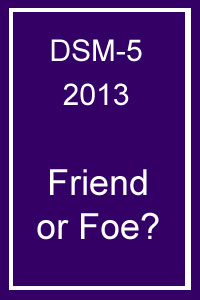
Does the DSM-5 represent a fundamental improvement in how disorders are conceptualized and diagnosed, or are the changes in the new manual flawed, unsafe, scientifically unsound, and costly to our society? Is the revision revolutionizing diagnosis and treatment, or was its process just an exercise in moving a few deck chairs on a sinking ship?
Every previous revision of the DSM has caused controversy. However, the process has never provoked such brutal warfare, with attacks coming from within the profession during and after the DSM-5 revision process. Discussions about the revised manual have stretched well beyond the world of academic psychiatry and have become a matter of intense public interest as well as media coverage.
Allen Frances, M.D., who chaired the DSM-IV revisions, expressed his disapproval with statements like:
“DSM-5 violates the most sacred tenet in medicine, First Do No Harm!” and “This is the saddest moment in my 45 year career of studying, practicing, and teaching psychiatry.”
DSM-5 is different from its predecessors in fundamental ways:
- The 5-axial diagnostic system has been removed, replaced by a non-axial documentation of diagnosis.
- Some diagnoses received major changes (for example, the removal of the bereavement exclusion and Asperger’s disorder).
- A few diagnoses were created to address newly recognized problems (for example, hoarding, excoriation (skin-picking), and premenstrual dysphoric disorder as well as caffeine and cannabis withdrawal).
Opponents complain that the DSM-5 introduces untested diagnoses that turn everyday life problems into mental disorders. For example, it will:
- Turn the temper tantrums of children into disruptive mood disregulation disorder;
- Turn the normal forgetfulness of old age into minor neurocognitive disorder;
- Turn gluttony into binge eating disorder; and
- Consider grief as a major depression.
- Many have warned us that the big winners of the DSM-5 are the American Psychiatric Association, which is likely to collect over $130 million in DSM-5 sales alone, and the pharmacological industry, which is ready to help physicians prescribe remedies for all the new, tweaked and so-called “mental disorders” to the tune of billions of dollars.
- Turning everyday, normal, and expected life struggles into ‘medicate-able’ mental disorders not only inflicts harm on those who are unnecessarily medicated, but is also likely to pull resources away from the unmet needs of those who could really benefit.
Did you know?
- As revisions may become an ongoing process, the Roman numeral “V” was abandoned in favor of the Arabic numeral “5”. Subsequent revisions will be referred to as version 5.1, 5.2, 5.3, etc.
- An electronic version of the DSM-5 will be available in late 2013.
- The new non-axial approach combines the former axes I, II, and III with separate notations for psychosocial and contextual factors (formerly axis IV) and disability (formerly axis V).
- The DSM-5 introduces a Cultural Formulation Interview for cultural assessment.
- Separation anxiety disorder now includes adults.
- The DSM-5 replaced the term gender identity disorder with gender dysphoria because the previous diagnosis was long considered stigmatizing by mental health specialists and lesbian, gay, bisexual and transgender activists.
- The powerful and influential National Institute for Mental Health (NIMH) claims that the dominance of the DSM system has hampered research and questions the validity of the revised manual.
- Starting on Oct. 1, 2015 the DSM-5 will be replaced by ICD-10. More information
- Some claim that according to the DSM-5 as many as 50% of the western population would be diagnosed as mentally ill.